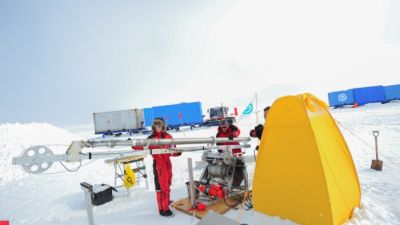
IceCon: Constraining Ice Mass Change in Antarctica
IceCon aims to gain a better understanding of the rate of the loss of ice – now and in the past - from the Antarctic ice sheet in the Dronning Maud Land area.
Knowledge of past ice volumes are important, since the ice sheet is still reacting to what happened in the past, especially since the Last Glacial Maximum (LGM), roughly 18,000 years ago, when the Antarctic ice sheet was significantly bigger. The study will provide local data for fine tuning and modifying large-scale ice sheet models.
IceCon’s main hypothesis is that the LGM ice sheet volume in Dronning Maud Land was not as big as previously predicted by large-scale ice sheet models, although it advances further towards the coast. Less grounded ice during the LGM implies less ice loss during deglaciation (the process of mass loss between LGM and now), making it difficult to associate a historical event – “meltwater pulse 1A” to the Antarctic ice sheet. Meltwater pulse 1A was rise of around 20m in sea levels that took place during a 500-year period, some 14,200 years ago.
The freshwater source for this pulse remains controversial, but understanding its source is important to understand its effects on oceanography and climate, and because it provides a potential analogue for rapid ice sheet deglaciation now, and in the future. Some researchers place the pulse in the Northern Hemisphere, while others advocate that this important ice loss stemmed from the Antarctic ice sheet. Understanding the past changes in ice sheet volume in Dronning Maud Land will definitely improve our understanding of future changes of the ice sheet in this area.
IceCon comprises six partners from several Belgian and foreign institutions: Université Libre deBruxelles (ULB), Royal Observatory of Belgium (ROB), University of Luxembourg (UL), Norwegian Polar Institute (NPI), and Aberystwyth University (AU).
Work during the BELARE expeditions
During the 2012-2013 BELARE season, the IceCon team installed two geodetic GPS systems that run all-year long. This puts serious constraints on power, so they relied on batteries powered by solar panels and wind turbines. One of the geodetic GPS systems has been set up on Seal, a small nunatak in the vicinity of Romnoesfjellet.
The purpose of the GPS systems is to monitor, over a four-year period, vertical changes of the lithosphere in response to the unloading of the ice due to post-glacial rebound. This will give IceCon insight into the volume of ice present in this sector of Antarctica’s Dronning Maud Land during the Last Glacial Maximum. This information is essential for constraining models of Glacial Isostatic Adjustment (GIA), which form the basis of the interpretation of the GRACE satellite signal. One GPS system has also been deployed on Derwael ice rise.
Understanding the dynamics of this ice rise will help understanding the deglaciation history as well. Ice rises are climate dipsticks that may tell us a lot on how the ice sheet behaved over the last thousands of years. By means of ice radar profiling and ice core drilling it is hoped to tie the ice dynamics of this area to the rest of the ice sheet.
During the 2013-2014 BELARE season, the team installed a new high precision cGPS station in the southern part of the Sør Rondane Mountains. All cGPS systems now lie along a stransect from the coast to the interior of the ice sheet, which makes it possible to determine the spatial variation of uplift in the range over the next coming years (until the end of the project). Additionally, the team visited and maintained the two stations installed during the 2012-13 season on Seal Nunatak and the Derwael Ice Rise on the King Baudouin Ice Shelf. The goal was to retrieve the data acquired during the austral winter and to re-install the Derwael station due to snow accumulation expected in this region.
During the 2014-15 BELARE season, four researchers spent nearly three weeks on the King Baudouin Ice Shelf. Despite difficult weather conditions on the ice shelf, the team managed to set up two GPS devices on the ice shelf (follow @tweetiniceshelf, funded by “les 10 km de l’ULB”, to get the latest updates on the movements of the ice shelf). The team also conducted many radar measurements, drilled a 107-metre ice core along with two 30-metre ice cores, all of which were brought back to Belgium for analysis. Finally, the team revisited the GPS points installed during the 2013-14 season.
Picture: Morgane Philippe and Jean-Louis Tison checking the new drilling equipment - © International Polar Foundation
